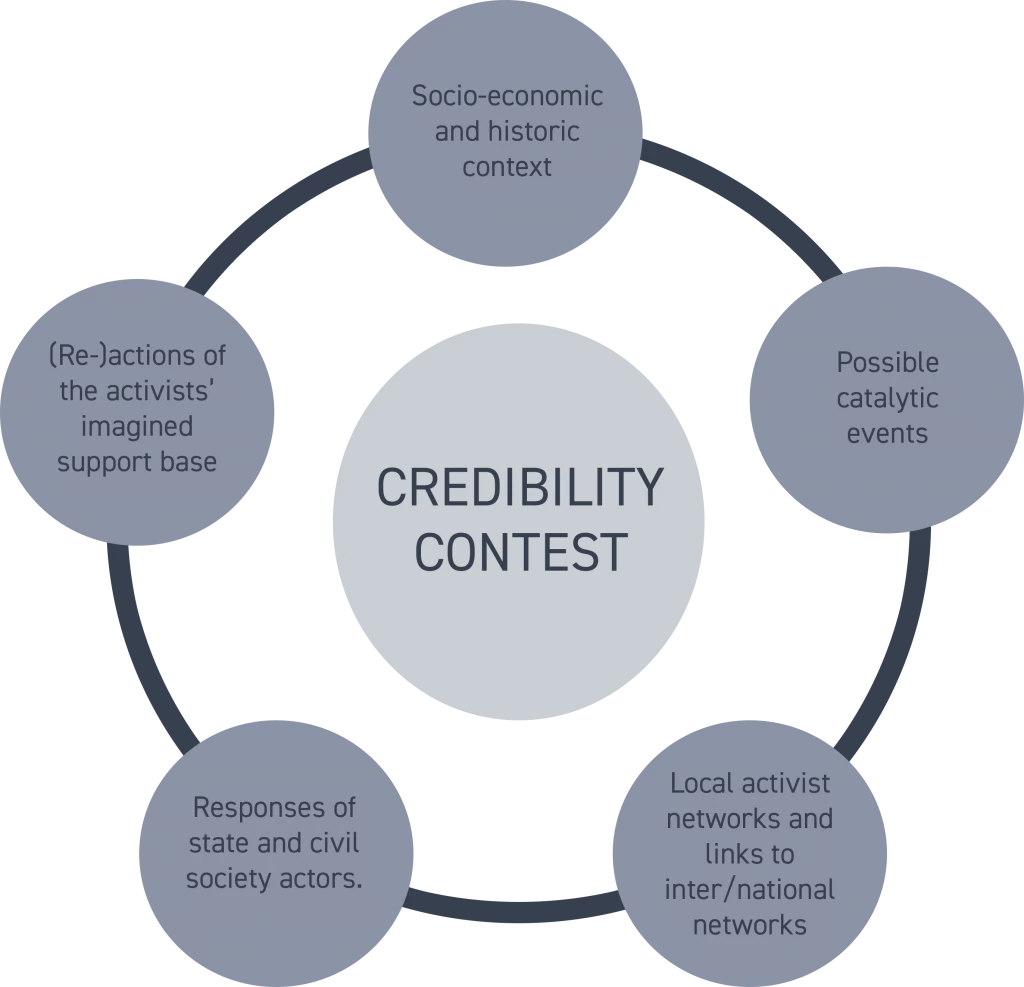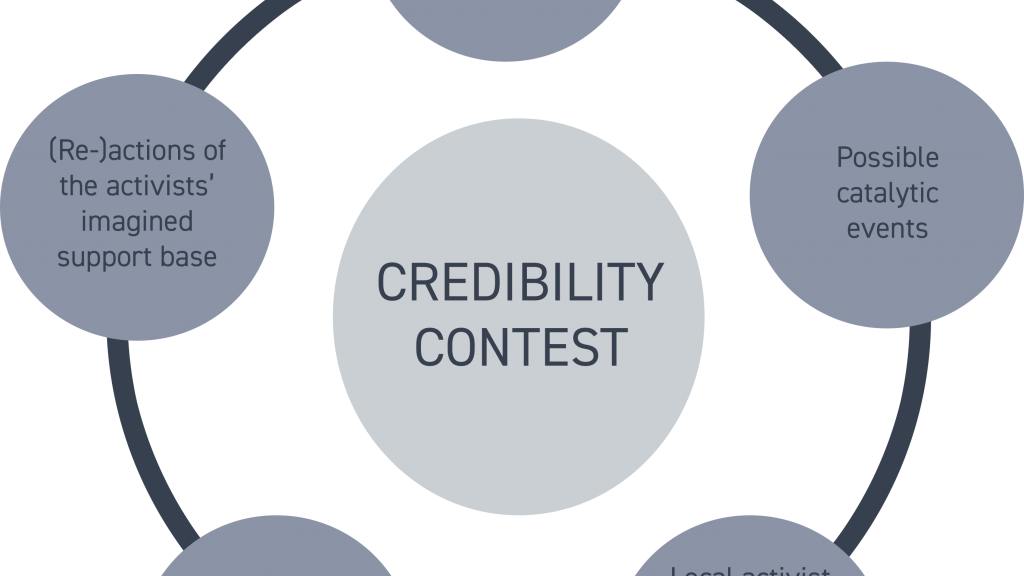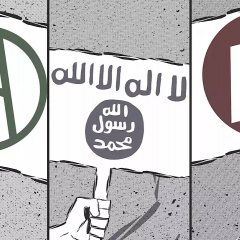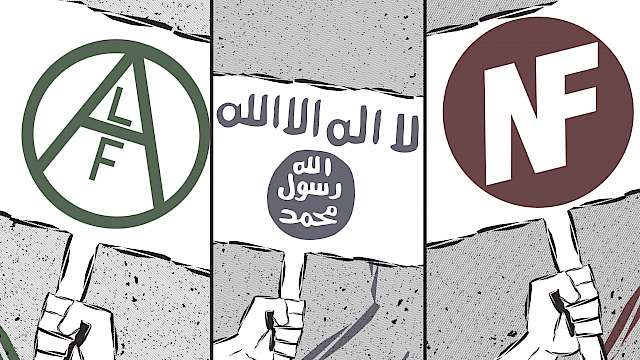Activism against ethnic, religious, sexual or other minorities is not an evenly-spaced challenge. Rather, at any given time, anti-minority mobilisations are likely to be more concentrated in particular cities, towns or even neighbourhoods. So why do some places become focal points for such activism at particular points in time, while other similar places do not? And what can we do to inhibit the ability of anti-minority activists to build support in any given place at any given time?
Drawing on comparative research on the trajectory of anti-minority activism in two English towns, we argue that one way we can help to answer these questions is by understanding the ‘credibility contests’ in which these groups become engaged as they seek to gain traction.
In what follows, we first elaborate on the idea of ‘credibility contests’ before setting out a simple framework through which to analyse these contests. We argue that one of the key strengths of this framework is that it enables us to integrate ‘supply-side’ and ‘demand-side’ explanations for the growth or decline of anti-minority activism. In doing so, it helps us to achieve a more holistic understanding of such activism and how we might effectively respond to it.
Introducing the idea of credibility contests
Joseph Nye, the American Political Scientist, observes that all forms of politics are, ultimately, ‘a contest of competitive credibility’. Opposing actors try to enhance their own credibility in the eyes of those they see as their potential allies or supporters, while at the same time trying to undermine the credibility of their opponents. The greater the credibility that an actor has in the eyes of their target audience, and the less credibility that their opponents have, the more likely they are to be able to persuade that audience to accept and adopt their views about the world and the way that things should be done.
Some credibility contests are broadly symmetrical: opposing actors compete with one another for similar forms of credibility. Think, for example, of two or more political parties seeking to persuade the general public that they, rather than their opponents, should be entrusted with looking after the best interests of the country or the town.
Other credibility contests can be asymmetrical. For example, while activists in a social movement or pressure group might seek to undermine the credibility of a sitting national or local government, they might not seek to replace them directly. In addition, while members of a national or local government are likely to claim to be acting in the best interests of most, if not all, residents of their constituency, activists in a social movement or pressure group might often pursue the interests of a specific group or category of people – think for example of ‘NIMBY’ protests against specific construction projects.
In the case of anti-minority activism, we are more likely to see asymmetric credibility contests, with organised anti-minority groups claiming to speak for the interests of a specific, usually supposedly victimised or marginalised, constituency, such as ‘ordinary English people’, the ‘marginalised majority’, or other labels to that effect. The more successful they are at positioning themselves in this way in the eyes of the people that they are trying to appeal to, and the more effective they are at discrediting attempts by their opponents to undermine such claims, the more likely they are to be able to gain traction.
Analysing credibility contests: a five-part framework
The question then is how to explain when and under what conditions anti-minority groups are more likely to achieve successes within these credibility contests.
Drawing on our research, we propose a framework comprising five core components:
- The socio-economic and historic context of the place in question
- The possible catalytic events around which anti-minority activists can mobilise
- The local activist networks and the wider movement structures with which they are connected
- The responses of statutory agencies and civil society actors who are trying to inhibit the growth of anti-minority activism
- The actions of the people whose views and interests the anti-minority activists claim to represent.
The interactions between these five elements shape the outcome of the credibility contests.

1. The local socio-economic and historic context
Context matters: where anti-minority activists are able to successfully ‘plug into’ local narratives of grievance and frustration they are more likely to be able to build support. Based on our research, we can break this down into three parts:
- To what extent are there underlying observable processes of social change that might lend themselves to the formulation of grievance or threat narratives? For example, economic decline, rising poverty or crime, or rapid demographic change.
- To what extent does the town feature in national and international debates about specific social or policy ‘problems’ around which anti-minority activists seek to mobilise? Where a town is positioned as a ‘hotspot’ or ‘epicentre’ in national and international media narratives about particular policy issues, this is likely to increase mobilisation opportunities.
- Are there specific events within local histories (e.g., contentious legal rulings, decisions by the statutory authorities, instances of community tensions) that might be used by anti-minority activists to weave narratives in which current issues can be constructed as part of a longer history of injustice?
2. The possible catalytic events
While an uptick in anti-minority activism can emerge at any time, in most cases there will be some kind of event or series of events that act as a catalyst. This might be a contentious legal hearing; protests by groups that anti-minority activists consider as opponents or ‘the enemy’; terrorist attacks; or other news stories that might be used to demonise the minorities that they seek to mobilise against. It is important therefore to consider what such catalytic events might look like and what opportunities they might open up for anti-minority activism. It is also important however to think about what might stop an event acting as an effective catalyst. In our research, we identified a number of factors that might be relevant. These include:
- Timing: while several areas may experience events that would seem to provide mobilisation opportunities for anti-minority activists, it is likely that the first areas to experience those events will attract greater attention both from anti-minority activists and the media. Furthermore, towns that are among the first to experience mobilisation around a particular issue do not have the benefit of being able to learn from the experiences of other towns.
- How well the event fits with grievance narratives already circulating within the town, and wider media narratives about the town.
- The extent to which there are activists nearby with the wherewithal to mobilise quickly in response to the event and/or to engage national or international actors who can help them to amplify their mobilisation efforts.
3. The local activist networks and their ties to national and international networks
Anti-minority activism is more likely to take root and gather momentum when there are relatively local activists who: a) have the acumen and access to resources required to exploit mobilisation opportunities, and/or b) are able and willing to facilitate efforts by national or international activists to turn the town or city into a focus of attention.
Here, there are a number of points to consider:
- How ‘savvy’ are the local activists? Do they appear to have the acumen to exploit mobilisation opportunities as they arise, or at least the ability to learn and adapt as they go?
- How well linked are they to the communities they are trying to mobilise? Do they already have some ‘standing’ there, or do they have the charisma and links to local gatekeepers that enables them to forge bridges into those populations?
- Do they have links into wider national or international networks that they can leverage to bring in resources, such as campaign expertise, or legal and financial support?
- To what extent are local activists campaigning around issues that resonate with local residents, or are they adopting radical ideological positions that are out of step with the opinions of the people they are trying to mobilise?
- To what extent are the tactics that they use likely to be considered ‘appropriate’ or ‘respectable’ by the people they are trying to engage, or are they likely to be seen as ‘trouble-makers’? Not all violence is necessarily perceived to be ‘illegitimate’ – sometimes certain forms of violence can be seen as an appropriate, or at least understandable, expression of frustration and a desire for justice.
4. The response of statutory agencies and civil society actors who are trying to inhibit the growth of anti-minority activism
While catalytic events and the presence of savvy and well-connected activists might increase the likelihood of there being an uptick in activism, mobilisation opportunities and prospects can be inhibited by the responses of statutory agencies and civil society actors. Here again, we identified three issues that require particular consideration:
- Are the responses of the statutory agencies and civil society groups demonstrably consistent with the values that they claim to stand for (e.g., in most cases, respect for democratic values and equality, both before the law and in the distribution of social goods)? Anti-minority activists thrive on being able to accuse the ‘liberal establishment’ of supposed ‘hypocrisy’ and ‘double standards’.
- How well aligned are the responses to the specific type of activism that is taking place? Different types of anti-minority activism – more or less violent, using more or less overtly discriminatory ‘issue frames’ – require different responses. Attempts to manage, control, or inhibit activism that miss the mark might not only be ineffective but may even backfire. For example, if activists operate broadly through recognised democratic channels, such as petitions or community meetings, attempts to inhibit or close down those activities using legal instruments or other forms of disruption might provide opportunities for those activists to position themselves as victims, defenders of ‘free speech’ etc – a form of ‘jujitsu politics’ through which they use the (’over-’)reactions of state and civil society opponents to fuel their grievance narratives and, potentially, build public sympathy and support.
- Are there processes of information sharing and institutional learning in place among local statutory agencies and civil society groups? Those seeking to respond to or manage anti-minority activism are more likely to be successful when they are effectively tapping into good practice and intelligence that enable them to adapt in a changing strategic environment.
5. The actions of the people whose views and interests the anti-minority activists claim to represent
The actions of the people that anti-minority activists claim to speak for are also likely to be important in shaping the outcomes of the credibility contests. If prominent actors within that ‘constituency’ make clear that the activists do not speak for them, this can severely undermine the credibility of the activists’ claims. Conversely, if some people within the same imagined ‘constituency’ express support or sympathy for the activists, this can boost their credibility and their cachet with local people.
The actions of these people are likely to be particularly significant when the individuals involved are symbolically important within the grievance or conflict narratives of the groups in question. For example, in the case of anti-Muslim activism, this might include people that are positioned as the principal victims of ‘Islamification’, ‘political correctness’ etc., such as the victims of child sexual exploitation by a network of Muslim men, or the victims of an al-Qaeda inspired terrorist attack or people who have particular cachet by virtue of their social position or role, such as active or former members of the armed forces.
Conclusions: Putting it all together
It is undoubtedly difficult, if not impossible, to predict accurately and with certainty where and when anti-minority activism is likely to gain momentum and become a challenge for community relations. We would argue, however, that by paying attention to the credibility contests that underpin the ebb and flow of anti-minority activism, we can develop a sharper understanding of where and when there is an increased probability that such activism might gain traction.
We would also argue that careful attention to these credibility contests can be used to inform assessments about which response strategies might be most appropriate, and how different response strategies might play out on the ground.
We believe there are two key messages from this work. First, while underlying conditions of significant deprivation, potential catalytic events and the presence of savvy or well-connected activists can all make it more likely for a town to become a focal point for anti-minority activism, it does not guarantee it. What matters is how these different elements connect to one another and how effectively those seeking to inhibit the growth of anti-minority activism can disrupt the alignment of these factors.
Second, while it is undoubtedly important to try to challenge the credibility of those who are putting forward anti-minority positions, it is just as important to invest time and energy in building up and deepening the credibility of local state and civil society actors.
Copyright Information
As part of CREST’s commitment to open access research, this text is available under a Creative Commons BY-NC-SA 4.0 licence. Please refer to our Copyright page for full details.






